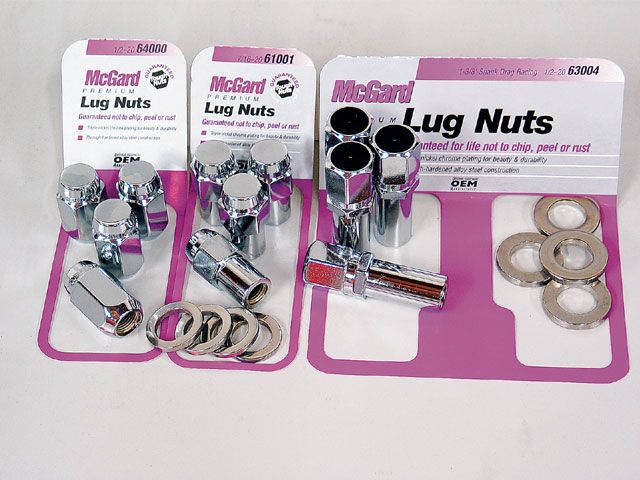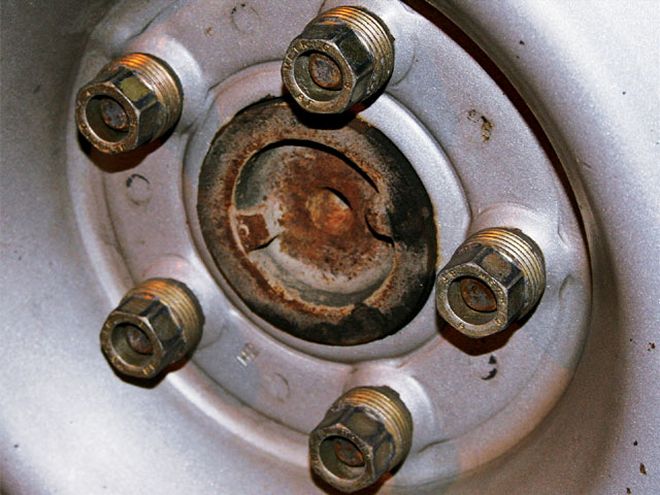
We've said it before, but it's a fact that few things are as simple as they look. Take something as commonplace as lug nuts: They hold the wheels onto a vehicle. That's simple enough, but another important function is to position the wheel correctly, and that's a little more complicated. Basically, there are two types of lug nuts: cone-seat and shank style. The lug you choose depends on the wheels you use. Most factory and many aftermarket wheels use the cone-seat style, which most of you are familiar with. The taper of the lug nuts matches the seating surface around the holes in the wheels. As the lug nuts are drawn tight, the wheel is centered on the mounting flange. Mag wheel, or shank-style, lug nuts center the wheel on the studs by virtue of an extended shank that fits into the wheel's bolt-hole bores. In either case, the trick is to use the correct lug nut for the wheel and stud combination.
We recently swapped wheels on one of our trucks and found that the wheels were loose even though the lug nuts seemed tight. The problem turned out to be the lug nuts. To make sure this doesn't happen to you, verify the proper fitment for your application. With cone-style lug nuts, the nut tightens the wheel before the stud bottoms out in the nut. Shank-style lug nuts have to tighten the wheel before the stud bottoms out in the nut or the shank hits the brake drum or rotor. According to lug manufacturer McGard, minimum thread engagement must be equal to the wheel stud's thread diameter with either type. If you change the wheels on your truck, take a minute to verify the fit of the lug nuts. It's a simple procedure, but that doesn't mean it isn't important.
Another simple yet highly overlooked procedure is installing your lug nuts with the proper torque specification for the stud size. Unless specifically stated otherwise, wheel lug torque specifications are for clean, dry threads (no lubricant) free of dirt, grit, etc. Using oil, grease, or antiseize lubricants on the threads will give an inaccurate torque reading that will cause the lugs to be overtightened. Also, give the wheel studs a good look and make sure there aren't any galled threads, which will also give false torque readings. Always use an alternating star pattern while torquing the lug nuts, and skip around to each one several times until they're all at their proper torque value. Be careful, because if you overtorque a wheel, you can strip a lug nut or hub, stretch or break a stud or bolt, and cause the wheel, brake rotor, and/or brake drum to distort. Overtightening can damage the lug nuts, studs, wheels, and brake components, which could all lead to dangerous if not deadly consequences. Be sure to check with the manufacturers of both your wheels and brake/axle components for their recommended torque specs.
There you have it-go nuts! Hopefully the last three DIY installments have helped shed light on the mundane yet mysterious side of what we all drive and rely on no matter what badge our trucks may wear.
Lug Nut Torque Specs Lug Size Ft-Lb Torque 7/16" 55-65 1/2" 75-85 9/16" 95-115 5/8" 135-145 12mm 72-80 14mm 85-95 These are ballpark torque values for common wheel stud sizes to be used temporarily until checking with your manufacturer. Lug nuts should be retorqued after the first 50-100 miles of driving after changing your wheels. When rechecking, torque the value, wait for the wheels to cool to the outside temperature, and never torque a hot wheel.

While today there are many variations of cone-style lugs to suit all the different makes and models of vehicles, one of the more popular on late-model domestic trucks are like these. But there are two differences here, one potentially hazardous. These open-back cone-style lug nuts have a metric thread and require a metric socket or wrench to install or remove them; they are usually marked with a metric size stamped into them. NEVER force a lug nut onto a wheel stud! Metric lug nuts will start to thread on an SAE stud, and many have been forced into place with an impact wrench, which ultimately ruins the lug, stud, and possibly the hub, brake rotor, or even the wheel, which starts to get expensive.